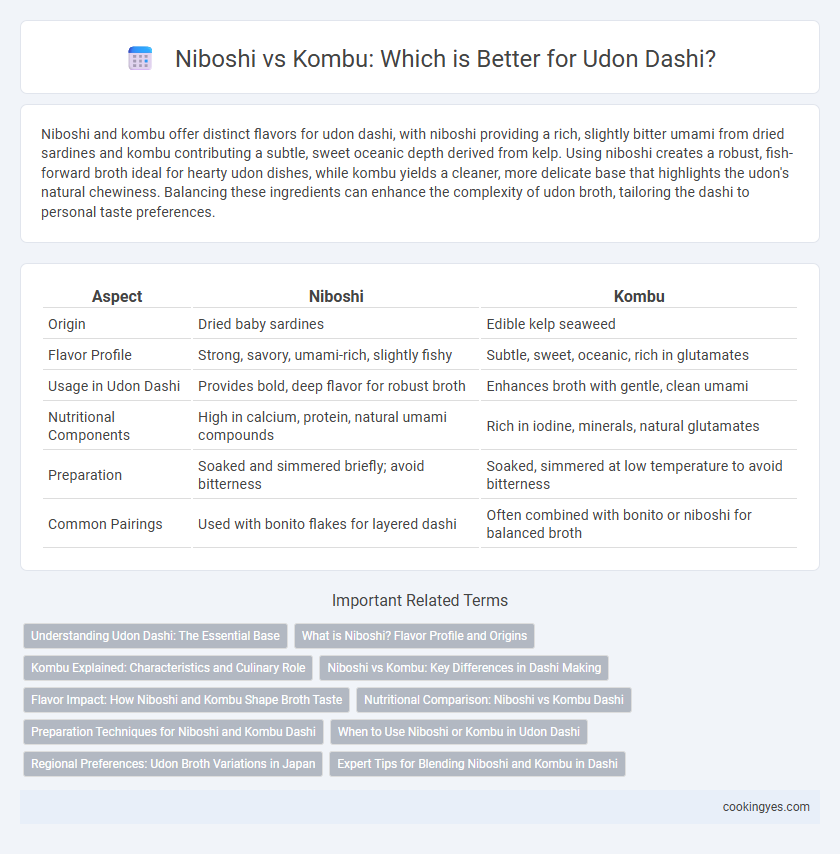Niboshi and kombu offer distinct flavors for udon dashi, with niboshi providing a rich, slightly bitter umami from dried sardines and kombu contributing a subtle, sweet oceanic depth derived from kelp. Using niboshi creates a robust, fish-forward broth ideal for hearty udon dishes, while kombu yields a cleaner, more delicate base that highlights the udon's natural chewiness. Balancing these ingredients can enhance the complexity of udon broth, tailoring the dashi to personal taste preferences.
Table of Comparison
| Aspect | Niboshi | Kombu |
|---|---|---|
| Origin | Dried baby sardines | Edible kelp seaweed |
| Flavor Profile | Strong, savory, umami-rich, slightly fishy | Subtle, sweet, oceanic, rich in glutamates |
| Usage in Udon Dashi | Provides bold, deep flavor for robust broth | Enhances broth with gentle, clean umami |
| Nutritional Components | High in calcium, protein, natural umami compounds | Rich in iodine, minerals, natural glutamates |
| Preparation | Soaked and simmered briefly; avoid bitterness | Soaked, simmered at low temperature to avoid bitterness |
| Common Pairings | Used with bonito flakes for layered dashi | Often combined with bonito or niboshi for balanced broth |
Understanding Udon Dashi: The Essential Base
Niboshi and kombu are fundamental ingredients in udon dashi, each offering distinct umami profiles essential for authentic flavor. Niboshi, dried sardines, provide a rich, slightly bitter depth with strong amino acid content, enhancing the broth's savory intensity. Kombu, a type of kelp, contributes a subtle sweetness and abundant glutamic acid, creating a balanced, clean dashi base that harmonizes perfectly with udon noodles.
What is Niboshi? Flavor Profile and Origins
Niboshi are dried infant sardines commonly used in Japanese cuisine to create a rich, umami-packed dashi for udon broth. Their flavor profile is intensely savory with a slight fishy undertone and subtle bitterness, contributing depth and complexity to the soup base. Originating from traditional fishing practices in Japan, niboshi dashi offers a robust alternative to kombu, which provides a more delicate, seaweed-based umami.
Kombu Explained: Characteristics and Culinary Role
Kombu, a type of edible kelp rich in glutamic acid, imparts a deep umami flavor essential for authentic udon dashi. Its mineral content enhances the broth's nutritional profile while providing a smooth, slightly sweet taste that balances the savory notes of other ingredients. Unlike niboshi, kombu produces a cleaner, less fishy broth, making it ideal for subtle, delicate udon preparations.
Niboshi vs Kombu: Key Differences in Dashi Making
Niboshi and kombu are essential ingredients in udon dashi, each imparting distinct flavors. Niboshi, dried baby sardines, provide a rich umami and slightly fishy depth, enhancing the broth's savory intensity. Kombu, a type of kelp, offers a subtle, clean, and sweet umami, contributing a delicate oceanic flavor with less bitterness compared to niboshi.
Flavor Impact: How Niboshi and Kombu Shape Broth Taste
Niboshi imparts a rich, umami-packed depth with a slight bitterness that enhances udon dashi's savory complexity, creating a robust and slightly fishy flavor profile. Kombu contributes a subtle, sweet umami and mineral richness, giving the broth a clean, rounded, and delicate taste that balances heavier ingredients. Combining niboshi and kombu in udon dashi allows for a harmonious blend of intense umami and gentle sweetness, resulting in a deeply layered and flavorful broth.
Nutritional Comparison: Niboshi vs Kombu Dashi
Niboshi dashi, derived from dried sardines, offers a rich source of calcium, protein, and omega-3 fatty acids, enhancing both nutrition and umami flavor in udon broth. Kombu dashi, made from edible kelp, contains abundant iodine, dietary fiber, and essential minerals like potassium and magnesium, promoting thyroid health and digestive benefits. Choosing between niboshi and kombu dashi depends on desired nutritional focus: niboshi for protein and omega-3, kombu for minerals and fiber support.
Preparation Techniques for Niboshi and Kombu Dashi
Preparation of niboshi dashi involves soaking dried sardines in water to extract rich umami flavors before gently simmering them to avoid bitterness, while kombu dashi requires soaking kelp in cold water followed by heating just until near boiling to preserve its delicate glutamates. Niboshi must be cleaned by removing heads and entrails to prevent off-flavors, whereas kombu is often wiped lightly to remove surface impurities without washing away natural umami compounds. Timing and temperature control are critical in both methods to maximize the depth and clarity of the resulting udon broth.
When to Use Niboshi or Kombu in Udon Dashi
Niboshi provides a rich, umami-packed flavor ideal for hearty, robust udon dishes like kitsune or curry udon, while kombu offers a subtle, clean taste perfect for lighter broths such as kake udon or zaru udon. When a deep, savory intensity is desired, niboshi's anchovy-based dashi enhances the overall depth of the soup. Kombu is preferred in recipes aiming for a delicate, balanced broth that highlights the natural flavor of the udon noodles and toppings.
Regional Preferences: Udon Broth Variations in Japan
In Japanese udon dashi, niboshi (dried sardines) dominate in regions like Kagawa and Hiroshima, offering a robust, slightly bitter flavor that enhances thicker udon noodles. Kombu (kelp) prevails in the Kansai region, imparting a subtle umami and clean taste preferred for lighter, delicate udon broths. These regional preferences reflect local palates and ingredient availability, shaping distinct udon broth profiles across Japan.
Expert Tips for Blending Niboshi and Kombu in Dashi
Combining niboshi and kombu in udon dashi creates a balanced umami profile, with niboshi imparting rich, deep fish flavors and kombu contributing subtle sweetness and minerals. Expert tips recommend soaking kombu in cold water to extract natural glutamates, then gently simmering niboshi to avoid bitterness, blending both for a well-rounded broth. Adjusting the niboshi-to-kombu ratio allows customization of flavor intensity, enhancing the overall depth and complexity of udon soup.
Niboshi vs Kombu for udon dashi Infographic

 cookingyes.com
cookingyes.com